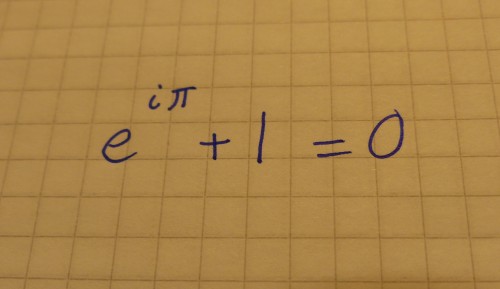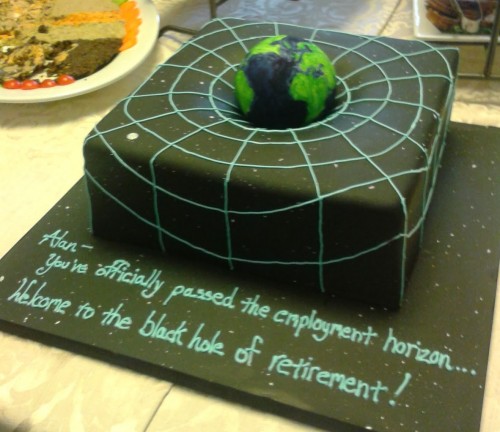Posts by: James Dacey
British scientists from ethnic minority backgrounds share their life stories
By James Dacey
What does it mean to be a scientist from an ethnic minority background? Is it harder to get career breaks and to reach the top of a field? Can your background actually be a source of inspiration? Is it even useful to anyone to be discussing these questions?
These are among the issues touched upon in a new series of video interviews with 10 British scientists with minority ethnic heritage. The interviews were conducted by researchers at the British Library as part of a larger audio history project commissioned by the Royal Society called Inspiring Scientists: Diversity in British Science. You can watch all 10 interviews on the Royal Society website.
What makes an equation beautiful?
By James Dacey
Earlier this year I wrote about a psychology experiment that revealed that mathematicians appreciate beautiful equations in the same way that people experience great works of art. In the experiment, which conjures up a slightly comical scene, mathematicians were hooked up to a functional magnetic resonance imaging (fMRI) machine and asked to view a series of equations. When the subjects looked at equations they had previously rated as beautiful, it triggered activity in a part of the emotional brain associated with the experience of visual and musical beauty. The formula most commonly rated as beautiful in the study, in both the initial survey and the brain scan, was Euler’s equation, eiπ+ 1 = 0.
Inspired by this study, we have put together this infographic to dissect the Euler identity and try to understand why so many mathematicians are enamoured with this little equation. Let us know what you think of the infographic and what you think are the most beautiful equations. Either post a comment below this article, or let us know on Twitter using the hashtag #BeautifulEquations.
View all posts by this author | View this author's profile
Student behaviour in the MOOCosphere

Does student behaviour online mirror the traditional classroom? (Courtesy: Shutterstock/wavebreakmedia)
By James Dacey
I’ve written a few times recently about the rise of massive open online courses, or “MOOCs” for short. If this trend in education has so far passed you by, MOOCs are online courses generally offered free of charge by some of the leading universities in the world. For example, Massachusetts Institute of Technology offers courses in classical mechanics and electricity & magnetism, and the University of Edinburgh has recently launched a course about the discovery of the Higgs boson.
MOOCs tend to combine video lectures with assignments such as problem sets and extended projects. In many ways, the course formats mirror or complement traditional classroom-based education, incorporating features such as forums where students can discuss the course content amongst themselves. Some of the science courses even include online “practicals” by way of virtual laboratories. But despite the proliferation of MOOCs in the past few years, very little research has been carried out on the way that students are actually engaging with the courses.
Now, a group of researchers in the US has done the first relatively detailed study of student behaviour in the MOOCosphere. The study is described in a paper published on the arXiv preprint server with lead author Ashton Anderson, a computer scientist at Stanford University. Anderson and his team examined the behaviour of the student population in courses offered by Stanford through Coursera, one of the major MOOC providers. The courses were on the topics of machine learning and probabilistic graphical models. After reading the study, it seems to me that the “take away” message is that MOOC students have many different motivations for taking these courses and as a result they behave in an assortment of ways, distinct from classrooms in the real world.
View all posts by this author | View this author's profile
Medical scanning demystified

Diffusion MRI scan reveals the connections in the brain. (Courtesy: NIH/The Human Connectome Project)
By James Dacey
Many of you reading this will have experienced (or at least known somebody else who has experienced) a medical scan of some type. Even if you have a background in physics, these procedures can seem mysterious and even slightly menacing, not helped by the clinical designs of the equipment and some of the sounds they make. A new series of online courses offered by an academic collaboration in Scotland has been designed to demystify the world of medical-imaging techniques by presenting the science and technology in non-technical ways.
The courses include introductions to ultrasound, magnetic resonance imaging (MRI), positron emission tomography (PET), and computerized tomography (CT). “The material was designed for non-specialists with an interest in science who might want to understand a bit more about medical imaging: school teachers, pupils, patients, relatives of patients,” says Dave Wyper, director of the Scottish Imaging Network: A Platform for Scientific Excellence (SINAPSE).
View all posts by this author | View this author's profile
Five celebrities who are quantum physicists in disguise
By James Dacey

(CC-BY Keven Law)
This week the Welsh pop star Charlotte Church (right) has released her latest EP entitled Four. In a conversation with New Scientist, Church explained that the EP’s opening track “Entanglement” was in fact named after the quantum-mechanical phenomenon known affectionately to physicists as “spooky action at a distance”. She has since told BBC Wales that she may well take her interest in science to the next level by studying for a physics degree.
There are of course several really famous people who are more directly connected with physics, having studied the subject in some form before going on to become luminaries in other fields. Examples include the Queen guitar-god Brian May, and arguably the most powerful woman in the world the German chancellor Angela Merkel. But Church is one of a new brigade of celebrities who are discovering the joys of physics after having already reached stardom for other abilities. The armchair psychologist might suggest that learning about the mechanics of the cosmos offers a refreshing alternative to the shallow nature of life that often comes with the celebrity lifestyle, or at least our view of it as presented by the media.
Bananaman, fusion boy, an astronaut and more
By James Dacey
The Red Folder is bulging this week with some weird and wonderful physics stories from around the Web. Here is a round-up of some of the best we have stumbled across.
One of the more eye-catching articles this week included the surreal image of Stephen Hawking posing for a picture with a bunch of men all dressed as Bananaman. In case you’re not familiar with this brilliant character, Bananaman is a comedy super hero created in the 1980s by British cartoonists who valued the importance of nutrition. When Eric Wimp – an ordinary British schoolboy – eats a banana he turns into our hero, a fully grown man in a blue and yellow suit with special powers to rival both Batman and Superman. Anyway, I digress. According to the Telegraph, the 10 besuited chaps in question were on a stag do in Cambridge. They were lost (perhaps a few too many banana liqueurs?) when they turned a corner and spotted the world-famous cosmologist getting out of a car. The result was a group shot with far more a-peel than any of those self-indulgent Oscars selfies that have been doing the rounds this week. Please accept my apologies for that bad pun.
View all posts by this author | View this author's profile
New prize targets student science journalism

Courtesy: iStock/Jay Lazarin.
By James Dacey
There are many routes into science journalism, and my own journey was certainly not carved into a stone tablet when I was a child. In short, I was always fascinated by the ideas and concepts of science but my real passion was the communication of those ideas to others. (I was also fairly useless at the practical aspects of my BSc in natural sciences.) It was only later on, during my Master’s degree when I started writing for the student newspaper, that I started to seriously think about making a career out of this journalism game. I vividly remember the excitement of seeing my name in print those first few times. The idea that someone might actually pay me to include my name in their publication was too much to resist.
I knew of course that I was not alone in this career choice. The crucial next step for any budding journo is to build a strong portfolio of work and achievements to mark you out from the crowd. This helps you to grab the attention of those potential employers, who will quite likely be hurling you straight onto the front line of their operation as a junior reporter.
View all posts by this author | View this author's profile
Beauty is in the eye of the mathematician

Is the Euler identity the most beautiful equation of them all?
By James Dacey
If you have ever talked with your arty friends about the sense of “beauty” you feel from maths, you may well have been greeted with a sympathetic smile. Perhaps even with jeers of derision. Well, next time you find yourself in that position you will have some scientific evidence to back up what you are saying. A group of researchers in the UK has demonstrated that getting your noggin around an equation can trigger the same part of the brain as staring at the Mona Lisa or listening to The White Album.
In an experiment described in Frontiers in Human Neuroscience, 15 mathematicians were presented with a series of 60 equations and asked to rate them for their beauty on a scale of –5 (ugly), through to +5 (beautiful). The same subjects were then hooked up to a functional magnetic resonance imaging (fMRI) machine and asked to view the same list of equations. It turned out that when mathematicians viewed the equations they had previously rated as beautiful, it triggered activity in a part of the emotional brain associated with the experience of visual and musical beauty.*
View all posts by this author | View this author's profile
Embracing the materials world
By James Dacey
Materials research is enjoying a new golden age. The hit parade of supermaterials that has been discovered in the relatively recent past is extensive. It includes the likes of high-temperature superconductors, quantum dots, bucky-balls, nanotubes, aerogels, silver nanowires and graphene. Meanwhile, new approaches to the commercialization of materials – such as the recent Materials Genome Initiative in the US – are improving the processes by which new materials are transferred from the science lab to practical applications in the real world.
In conjuction with these new discoveries, materials scientists have also made dramatic improvements to the tools they have available for studying and manufacturing materials. Here, the list of advances is seemingly endless. Researchers can now simulate, image and analyse materials with far more accuracy than ever before. Developments in production methods – such as the advent of 3D printing – are also enabling researchers to scale up their new materials with greater ease.
View all posts by this author | View this author's profile
Super Bowl, super-chilled leeches, a black hole cake and more

(Courtesy: Quantum/Mathelete/Buzz)
By James Dacey
Fire and ice will mix together in a sporting cauldron this Sunday. The Seattle Seahawks are taking on the Denver Broncos in the Super Bowl at the MetLife Stadium in New Jersey, and all weather forecasters agree that it’s going to be rather chilly. In fact, some have criticized the National Football League (NFL) for electing to play the game in a stadium without a roof, rather than opting to stage the match under cover. Bear in mind, the Super Bowl is the sporting event of the year in the US and people take it very seriously indeed. To address some of the concerns, The Huffington Post published this article to analyse how the mechanics of the game can change under cold conditions. The entertaining article considers everything from the reduced bounciness of the ball, to the increased propensity of helmets to break due to changes in material pliability.
View all posts by this author | View this author's profile